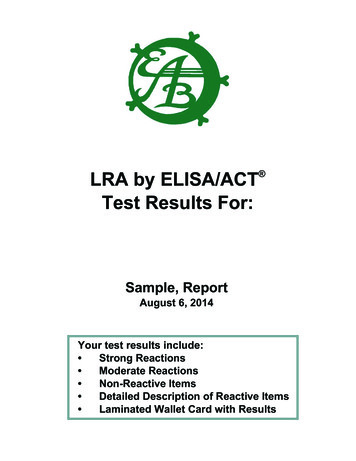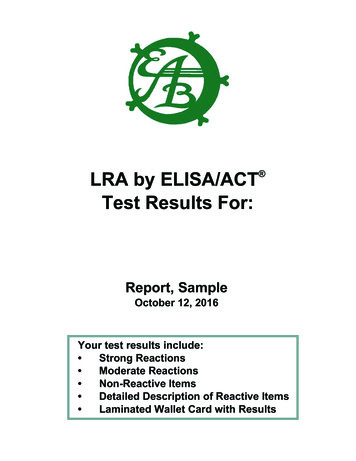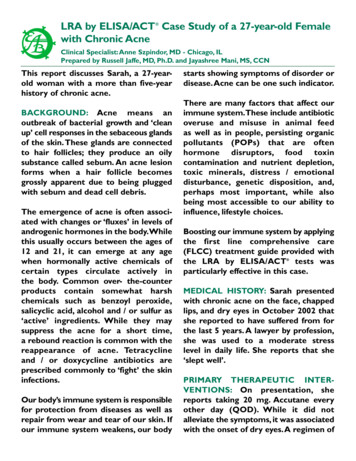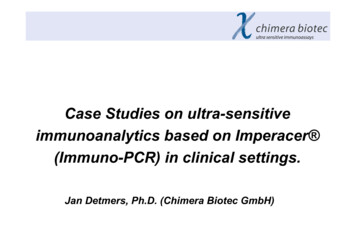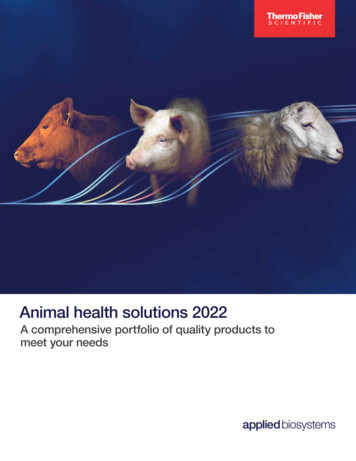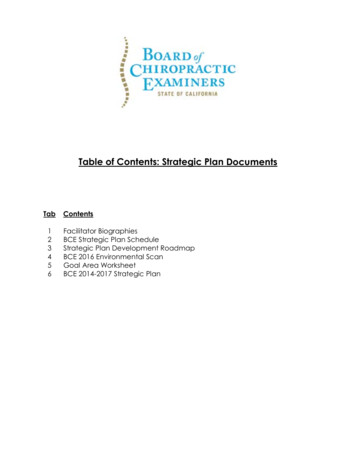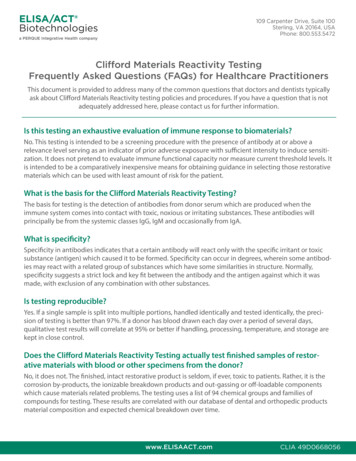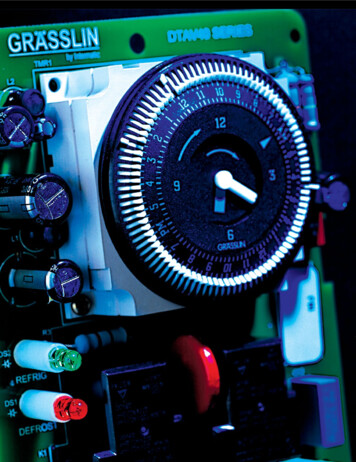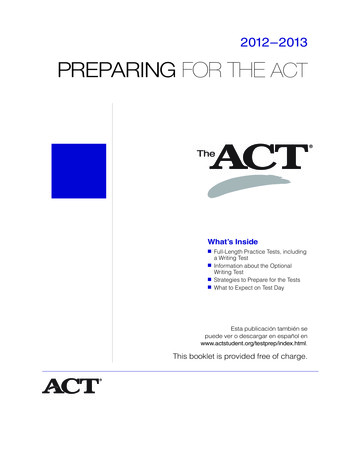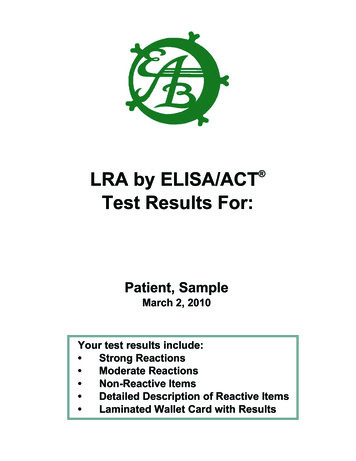
Transcription
LRA by ELISA/ACT Test Results For:Patient, SampleMarch 2, 2010Your test results include: Strong Reactions Moderate Reactions Non-Reactive Items Detailed Description of Reactive Items Laminated Wallet Card with Results
ELISA/ACT LRA RESULTSSTRONG REACTIONSPatient, Sample 62145March 2, 2010Avoid for at least 6 months. Orange Cheese, Brick (Cow) Cherry Tapioca Potassium Bromate Gum, Agar Silicates Ampicillin PenicillamineSTRONG FOOD GROUP(S): COW DAIRYButter (Whole)Cheese (Cow):BrickCottage CheeseParmesanProcessed CheeseLactalbuminLactoglobulinMilk (Cow):CaseinMilk, PasteurizedMilk, RawYogurtWheyMODERATE REACTIONSAvoid for at least 3 months. Potato, White Cola Pepper, Chili, Red Sesame/Tahini Sugar, Maple Bean, Garbanzo Macadamia Alternaria alternata Sodium Benzoate FD&C Green #3 D & C Green #5 BenzaldehydeResults1A
ELISA/ACT LRA RESULTSPatient, Sample 62145March 2, 2010MODERATE FOOD GROUP(S): NIGHTSHADESEggplantPepper, CayennePepper, ChiliBell Pepper, All ColorsPotato, WhiteTobaccoTomatoPaprikaPimientoThus of the 466 substances tested, reaction is noted to 21 items and 2 food group(s).While both strong and moderate reactions are equally burdensome to your immunedefense and repair systems, we have found that it takes about half as long to restoretolerance of moderate reactions as compared to the strong ones.Results2A
Patient, Sample3/2/201062145ELISA/ACT LRA RESULTSNON-REACTIVE ITEMS 1, 2 Dichlorobenzene 2-Methyl Pentane 2, 4, 5 T 2,4-D 3-Methyl Pentane Aldrin Alfalfa Algae (Chlorella) Algae (Spirulina) Allspice/Arrowroot Almond Aluminum Amaranth Amitriptyline (Elavil) Amoxicillin Anchovy Anise Seed Annatto Antimony Apple Apricot Arnica Arsenic Artemisia anua Artichoke Asparagus Aspartame/Nutrasweet Aspergillus Fumigatus Aspergillus niger Aspergillus oryzae Aspirin/Coal Tar Astragalus Avocado Baker's Yeast (Geotrichum) Baking Powder Banana Barium Sulfate Barley Basil Bass Bay Leaf Bean, Kidney Bean, Lima Bean, Mung Bean, Navy/Ninja Bean, Pinto/Frijole Bean, Soya Bean, String/Wax Beef/Veal Beet Benzene Benzopyrene Benzyl Acetate Bergamot Beryllium Oxide BHA BHT Black Cohash Blackberry Blueberry Bok Choi Botrytis cinerea Boysenberry Brazil Nut Brilliant Black Broccoli Buckwheat/Kasha Buffalo Butter, Clarified (Ghee) Cabbage/Brussels Sprouts Cadmium Caffeine Calcium Propionate Candida albicans Cantaloupe/Honeydew Caraway Seed Carbamates Carbon Disulfide Carbon Tetrachloride Carmine/Cochineal Carmoisine Carob Carrot Cashew Cat Dander (Felis cattus) Catfish Cauliflower Celery Cellulose/Hemicellulose Cephalexin (Keflex) Chamomile Chard Cheese, Romano (Sheep) Cheese/Milk (Goat) Chestnut Chicken Chinese Tea Chive Chlordane Chloroform Chocolate/Cocoa Chrysanthemum Cilantro Cinnamon Ciprofloxacin (Cipro) Cis-Dichloroethylene (1, 2 Cladosporium cladosporioides Cladosporium herbarum Clam Clarithromycin (Biaxin) Clove Coconut Cod Liver Oil Codfish Codium Coffee, Decaf & Reg Collard Greens Coriander Corn (Maize) Cottonseed Oil Crab Cranberry Cucumber Cucumber, Japanese Cumin Currant Curry Cyclohexylamine D & C Orange #5Results1B
ELISA/ACT LRA RESULTSPatient, Sample3/2/201062145NON-REACTIVE ITEMS, CONT'D D & C Red #33 D & C Violet #2 Dahlia Flower (Cultorum) Dashi Kombu Date DBCP (1,2 Dibromo-3-chloropropane) DDT Deer/Venison DEET Detergent (Synthetic) Diacetyl (2,3-Butanedione) Diazepam (Valium) Dibutyl Phthalate Dieldrin Dill Docosanol (Abreva) Dog Dander (Canis familiaris) Dong Quai Dried Laver Duck Feathers (Anas platyrhynca) Duck/Goose Echinacea Eel Egg White (Chicken) Egg Yolk (Chicken) Elk Endive Endrin Ephedra Epidermophyton floccosum Erythromycin Ethyl Acetate Ethyl Acetoacetate Ethyl Butyrate Ethylene Dibromide FD&C Blue #1 FD&C Blue #2 FD&C Orange #4 FD&C Red #2 FD&C Red #3 FD&C Red #40 FD&C Yellow #10 FD&C Yellow #5 FD&C Yellow #6 Feverfew Fig Flaxseed/Linseed Oil Fluconazole (Diflucan) Formaldehyde Fusarium vasinfectum Garlic Gelatin Gin (Juniper Berries) Ginger Ginseng, American Ginseng, Chinese Ginseng, Siberian Gliadin Gluten Goat Hair/Skin Scraping (Capra hircus) Gold Goldenseal/Hydrastis Goose Feathers (Anser anser) Grape Seed Oil Grape/Raisin, Green Grape/Raisin, Red Grapefruit Guaifenesin (Mucinex) Guinea Pig Hair (Cavia porcellus) Gum, Acacia Gum, Carrageenan Gum, Guar Gum, Locust Bean Gum, Tragacanth Gum, Xanthan Haddock Halogenated Biocide Hawthorne Hazelnut/Filbert Helminthosporium halodes Helminthosporium sativum Heptachlor Hexachlorocyclohexane Hijiki Honey Hops Horse Dander (Equus caballus) Horseradish Hydrogenated Oil Hydroxychloroquine (Plaquenil) Hypericum/St. John's Wort Ibuprofen Isopropyl Ether Kale Kamut Kelp/Sea Weed Kiwi Kombu Lamb/Mutton Latex Lead Leek Lemon Lemongrass Lentils, Red, Green Lettuce, Iceberg Lettuce, Red Leaf Lettuce, Romaine Licorice Lime Lobster Lomatium Mace Maleic Anhydride Malt Mango Marjoram Mercury Mesalamine (Asacol) Metallic Catalysts Methoxychlor Methylene Chloride (Dichloromethane) Methylphenidate (Ritalin) Millet Miso, Barley Miso, Brown Miso, Hatcho Miso, White MolassesResults2B
ELISA/ACT LRA RESULTSPatient, Sample3/2/201062145NON-REACTIVE ITEMS, CONT'D Morpholine MSG (Monosodium Glutamate) Mucor mucedo Mucor racemosus Mushroom Mushroom, Shiitake Mushroom, Straw Mushroom, Wood Ear Mustard Greens, Spice Naproxen Nectarine Nickel (II) Chloride Nitrates/Nitrites Nitrosamine Mix Nutmeg Nystatin Oats Okra Olive Omeprazole (Prilosec) Onion, Yellow Oregano Organophosphates Oyster Papaya Parsley Parsnip Pea, Black-Eyed Pea, Green, Snow Peach Peanut Pear Pecan/Pine Penicillin Penicillium chrysogenum Penicillium frequentans Penicillium notatum Penicillium roqueforti Pentachlorophenol (PCP) Pepper, Black Pepper, White Peppermint Perch/Mackerel Petroleum By-Products & Solvents Phenol Phthalates Pineapple Pinene Piroxicam (Feldene) Pistachio Plum, Umeboshi Plum/Prune Poke Weed Mitogen Polysorbate 60 Polysorbate 80 Polyvinylpyrrolidone Ponceau 2R Ponceau 4R Poppy Seed Pork/Bacon/Ham Potato, Sweet/Yam Primrose Oil Propyl Gallate Propylene Glycol (1,2-Propanediol) Psyllium Seed Pullularia pullulans Pumpkin Pyrene Quail Quinoa Rabbit Rabbit Hair (Oryctolagus cuniculus) Radish Rapeseed/Canola Oil Raspberry Red Oil Resin Rhizopus nigricans Rhizopus stolonifer Rhodotorula Rhubarb Rice, Basmati Rice, Brown Rice, White Rice, Wild Rose Hips Rosemary Royal Jelly Rutabaga Rye Saccharine Safflower Oil Sage Salicylate Salmon/Lox Sardine Scallion/Spring Onion Scallop Sea Cucumber Selenium Sulfide Sheep Wool (Ovis aries) Shrimp Silicone Silver Slippery Elm Snake (Rattle) Snapper Soap (SDS/SLS) Sodium Fluoride Sodium Propionate Sole/Flounder/Halibut Sorbitol Spearmint Spelt Spinach Squash Strawberry Streptomycin Sucanat Sugar, Beet Sugar, Cane Sugar, Corn Sulfite/Metabisulfite Sunflower Swordfish Tamari Tamarind Tangerine/Mandarin Orange TarragonResults3B
ELISA/ACT LRA RESULTSPatient, Sample3/2/201062145NON-REACTIVE ITEMS, CONT'D Tea, Black Tert-Butyl-Ethyl Ether (TBEE) Tert-Butyl-Methyl Ether (TBME) Tetrachloroethylene Tetracycline Thricothecium roseum Thyme Tin/Stannous Chloride Titanium Dioxide Tofu Toluene Trichloroethylene (TCE) Trichophyton Trichophyton mentagrophytes goetzii Trichophyton mentagrophytes interdigit Trichophyton rubrum Trichophyton schoenleinii Triticale Trout Tuna Turbot/Whitefish Turkey Turkey Feathers (Meleagris gallopavo) Turmeric Turnip, Greens Tylenol (Acetaminophen) Valerian Vanilla Vinyl Chloride Wakame Walnut Oil, Black Walnut, English Water chestnut Watercress Watermelon Wheat White Willow Bark Xylene Xylitol Yaki Nori Yeast, Brewer's (Torula)Results4B
Patient, Sample 62145March 2, 2010Interpretation of ELISA/ACT LRA Test ResultsLymphocytes exposed to antigens to which they have become sensitized in the body ("recall antigens") activate whenthey react with these substances under controlled laboratory conditions. Lymphocytes react to antigen-specific,complement-activating antibodies (IgA, IgM, and IgG), Ig-M-anti-IgG immune complexes, and cell-mediated directlymphocyte antigen recognition. Briefly, mixed cell cultures in patient autologous plasma are exposed to the foreignantigen in pre-coated incubation plates cultured under ex-vivo conditions, and lymphocytes are observed for reactivity.Reaction indicates loss of tolerance and development of hypersensitivity. Strong reaction means that 50% of cultured lymphocytes react. Moderate reaction means that 5-50% of cultured lymphocytes react.Avoidance of strong reactors for six (6) months and moderate reactors for three (3) months can reduce the load on theimmune system. The goal of avoidance of reactive substances is to allow immune mechanisms to reset. This can restoretolerance, enhance repair, and reduce the autoimmune and immune dysregulation load on the body’s defense systems.Only if you reacted to a food group(s), it will be displayed on the test result summary sheet. A complete food group isnoted when two or more foods in that group are reactive. The only exception to this is dairy because it is commonly foundto be cross-allergenic. Therefore, the dairy group will appear in bold if even one item in that group is reactive. It isrecommended to avoid all items in a food group if it is in bold. Please see your health professional for moreinformation.Reactive items are an adverse load on your body’s immune defenses. This means a reduced ability to respond to new orchronic infections. Reactive items also decrease immune activities needed to repair your body. This can provokeinflammation and self-attack ("autoimmunity"). Avoiding reactive items can break the cycle of impaired defense andrepair, allowing your body to start the recovery and repair process.Immediate reactions (IgE linked) are usually detected by routine skin tests or RAST tests.Protective memory (non-reactive IgG) antibodies do not provoke symptoms and are not affected by ELISA/ACT LRAtests. This is an advantage of lymphocyte response assays in detecting only the items that provoke reactions.Cross-reaction between intestinal pathogens and items tested can occur. It is possible to react to an item that is not eaten.Improved digestive health can replace these pathogens with healthy organisms, reducing this source of reactivity.Occasionally, people have metabolic (non-immune) reactions. ELISA/ACT LRA tests measure only immune delayedhypersensitivity.MD, Ph.D., FASCP, FACAAI, FACNReferences: Golub, E.S. Immunology: A synthesis Sinauer Associates, Inc. , Sunderland, MA 1987 p474-479. Sell, S. Immunology,Immunopathology, and Immunity, 4th Ed., Elsevier, NY, 1987 p 314-321. Jaffe, R. Improved Immune Function Using Specific NutrientSupplementation and ELISA/ACT “Immunologic Fingerprint” to Detect Late Phase Responses Ex Vivo. J Am Col Nutr 8(5): 424, 1989.
Patient, Sample 62145Description of Items:March 2, 2010OrangeHistory : Oranges are the largest citrus crop in the world. The two most common varieties of oranges are navel orangesand valencia oranges.Sources of Exposure: Fresh fruit, juices and vegetable salads Take care to check for fruit sweeteners and natural fruitflavorings in beverages, baked goods, jams, jellies and candies.Substitutions: Non-reactive citrus fruits and juices.Cheese, Brick (Cow)Items Tested: The DAIRY category includes Butter, Whole; Butter, Clarified (Ghee); Cheese, Brick (Cow); Cheese,Cottage (Cow); Cheese, Parmesan (Cow); Cheese, Processed (Cow); Casein; Lactalbumin; Lactoglobulin; Milk,Pasteurized (Cow); Milk, Raw (Cow); and Yogurt (Cow). Casein, Lactalbumin and Lactoglobulin are various proteinsfound in dairy products. Ghee or clarified butter is a derivative of butter. It is made by melting butter and removing allthe milk solids.History/Discussion: If you are reactive to one or more products in the cow DAIRY family, it will be listed on your resultsin bold as DAIRY. This is done to draw your attention to the greater possibility of cross-reactivity to other dairyproducts, possibly resulting in the development of more reactions in this group. Therefore, it is recommended that youavoid all cow dairy products . The only exception to this avoidance of all dairy recommendations involvesorganic ghee. Ghee or clarified butter is a derivative of butter. It is made by melting butter and removing all the milksolids. If you are shown sensitive to whole butter but not to clarified butter (ghee) you may try using organic ghee whileavoiding whole butter . Substitute as described below.Sources of Exposure: Sandwiches and baked goods containing solid cheese.Substitutions: Sheep and goat cheeses.CherryHistory/Discussion : The cherry fuit Prunus avium is a member of the Rosaceae family . It is native to Europe.Sources of Exposure: Take care to check for fruit sweeteners and natural fruit flavorings in beverages, baked goods,jams, jellies and candies.Substitutions: Any non-reactive fruit.1
Patient, Sample 62145Description of Items:March 2, 2010TapiocaHistory/Discussion: Tapioca is a highly starchy root vegetable in the spurge family.Sources of exposure: Chips, soups and other processed foods (check labels).Substitutions: Potato, yam or any other non-reactive starchy vegetable of choice.Note: Avoidance of specific foods to which you react is sufficient. There is no added benefit in avoiding a completefood family unless specifically directed to.Potassium BromateItems Tested: Potassium bromate is a colorless white crystal used as a flour-treating agent to improve the color and/orbaking qualities of flour; it is known as a dough extender or conditioner. It gives bread a sponge-like quality. Because itis a strong oxidizing agent, potassium bromate has also been used as a preservative to keep foods from spoiling.History/Discussion: Pure potassium bromate is very toxic when taken internally and has been reported to cause skinirritations and burns in industrial exposures to toothpaste. In toothpaste it has been reported to have causedinflammation and bleeding of gums. In 1980, the Ames Test found it to be a mutagen. The World Health OrganizationCommittee on Food Additives said in 1993 that new data about potassium bromate showed long-term toxicity andcarcinogenicity with possible effects including kidney tumors, tumors of the stomach lining, thyroid tumors in rats andslightly increased kidney tumors in hamsters. On the basis of the new safety data and the new data on residual bromatein bread, the committee concluded that the use of potassium bromate as a flour-treatment agent was not appropriate.Potassium bromate decomposes at high temperatures so fortunately most of it decomposes to potassium bromide (notan oxidizing agent) during the baking of bread. However, the health effects of either compound have not beenadequately addressed in humans. Kidney and ear damage can occur when toxic amounts are ingested. Exposure tothis substance during pregnancy has been associated with severe problems for the infant, perhaps the most urgentconcern with this compound. Interestingly, the deleterious effects of its oxidation of body tissues can be noted inlaboratory testing and this deterioration can be prevented with the use of glutathione and/or cysteine.Sources of Exposure: Found as an additive in breads and baked goods. Potassium bromate is also used in over-thecounter products such as mouthwash, toothpaste, home hair wave/permanent solutions and some photographicsupplies. In Europe, vitamin C is used as a replacement for bromate; breads and baked goods labeled 'non-bromated'can now be commonly found.Substitutions: Non-bromated flours (such as King Arthur and Erewhon) are increasingly available.2
Patient, Sample 62145Description of Items:March 2, 2010Gum, AgarItem Tested: Agar agar, also known as agar gum, is a tasty gel made from Gelidium amansii, a red algae (the seaweeditself is konwn simply as agar).History/Discussion: Agar agar is a versatile, tasty gel that sets at room temperature. It is traditionally made in the Orientby rinsing, cleaning, sun bleaching and re-rinsing the specific red algae known as Gelidium amansii. After this initialprocess the seaweed is boiled and poured through filters and into frames. Then the mixture is freeze-dried, recleanedand redried, producing feather-light translucent bars. Flakes from these bars, known as agar flakes, are used toproduce agar gel. Agar gum can be used as a mild laxative, but its most important function is as a food. The Japanesegelatin dessert, kanten, is made from agar gum.Sources of Exposure:Agar gum may be found in certain health and oriental food products as a thickening agent. It is also a common elementin Japanese cuisine and may be found in Japanese desserts, as well as other dishes.Substitution:Any other non-reactive thickeners such as: kudzu, corn starch and arrowroot.Silicates & Silicon DioxideItems Tested: Silicates are salts or esters derived from silicic acid. These are complex metal salts that contain siliconand oxygen. The simplest silicate is sand, silicon dioxide, which is comprised of one silicon atom combined with twooxygen atoms.History/Discussion: Silicate derivatives are commonly used as food additives to prevent caking and lumping. The typicalsilicate additives used include: aluminum silicate, calcium silicate, sodium aluminosilicate, magnesium silicate, tricalciumsilicate, and sodium calcium aluminosilicate (hydrated). Although silicon dioxide is a food additive used as an anticaking agent in a wide variety of foods, it has numerous other uses. It is used as a stabilizer in making beer, as anadsorbent for l-alpha tocopherol (vitamin E) and other vitamins, as well as BHT, and as a diluent in the inks used tomark fruits and vegetables. It is not allowed in infant foods. The maximum amount allowed to be added to foods is 2%by weight, but the ADI (Adult Daily Intake; EPA) is probably higher than that. It is not a GRAS (Generally Regarded AsSafe; FDA) substance, but tolerance/acceptable intake levels have been developed based on the fact that specifictoxicologic effects cannot be demonstrated at the ADI dose. Many silicates are associated with aluminum, and althoughthese silicates are GRAS substances, aluminum and silicon together may have additive adverse health effects, apossibility which has not been adequately examined.Silicates and silicon dioxide are not to be confused with silica, a common nutritional mineral or with silicone, amanufactured polymer which encompasses a large group of oils, rubber, resins and other compounds derived fromsilica.Sources of Exposure: Some of the silicate derivatives are used in table salts or added to baking powder. Silicondioxide can be used in the manufacture of beer, in salt and salt substitutes, in sodium propionate, and as a vehicle fordelivering BHT and some vitamins.3
Patient, Sample 62145Description of Items:March 2, 2010AmpicillinItem Tested: Ampicillin is a form of penicillin known as an "extended-spectrum aminopenicillin'.History/Discussion: Ampicillin is a beta-lactam antibiotic, a semi-synthetic antibiotic structurally related to penicillin.Ampicillin therapy is associated with a higher incidence of rash than are other penicillins; ten percent as opposed to two percent.Most of the rashes associated with ampicillin occur at least one week after institution of therapy and occasionally as late as the thirdor fourth week after treatment has been discontinued.Sources of Exposure: Ampicillin is sold under various trade names including Augmentin, Clavulin, Alphamox, Amoxil, Trimox,Utimox and Wymox. Ampicillin is used in veterinary medicine as well as with humans, and therefore animal products may containtraces of the drug. This is another reason why those seeking to lower their immunologic load, increase host resistance and regainhealth should consume biodynamically or organically grown foods, including organic flesh food and dairy products.Substitutions: Other non-reactive antibiotics. At times natural herbal antibiotics and antioxidant nutrient supplement can replacechemical antibiotics. The use of a fully buffered Vitamin C (as the PERQUE Buffered Ascorbate, call our Client Servicesdepartment, 800-553-5472 for protocol) and a quercetin with proanthocyanidins (as the PERQUE Bio Quercetin, 1000 mg two tofour times a day) is helpful. High dose echinacea (1 tablespoon a day for 5 days a week) is both antibiotic and immune enhancing.Other herbs with an antibiotic action include astragalus, berberine (as from goldenseal), Oregon grape, barberry root, and garlic.PenicillamineItem Tested: Penicillamine, 3 Mercapto-D-valine is a non-metabolized amino acid.History/Discussion: Penicillamine is a chelating agent used in the treatment of lead poisoning, copper overload (Wilson's Disease),mercury overload and heavy metal toxicity in general. It is also used as a drug treatment for rheumatoid arthritis where it appears toinhibit collagen formation.Penicillamine is a recognized metabolite of penicillin. It is now, however, produced synthetically. Synthetically producedPenicillamine contains no penicillin antigen.Short term, occasional use of Penicillamine as a chelating agent, as per the protocol of Jaffe, 1996, is generally safe and effective.Longer term, daily use of this drug can lead to alternations in the white blood cells and damage to cell cross linking which has beenassociated with a lupus-like syndrome. Myasthenic syndrome is another adverse reaction associated only with long term use ofPenicillamine.Sources of Exposure: Penicillamine is sold under the trade names of Cupramine, Depen and D-Penamine.Substitutions: Non-chemical agents which help to remove heavy metals from the body include Vitamin C, garlic, the sulfur aminoacids methionine and cysteine, adequate water, higher fiber diets and sauna therapy.4
Patient, Sample 62145Description of Items:March 2, 2010COW DAIRYItems Tested: The DAIRY category includes Butter, Whole; Butter, Clarified (Ghee); Cheese, Brick (Cow); Cheese, Cottage(Cow); Cheese, Parmesan (Cow); Cheese, Processed (Cow); Casein; Lactalbumin; Lactoglobulin; Milk, Pasteurized (Cow); Milk,Raw (Cow); and Yogurt (Cow). Casein, Lactalbumin and Lactoglobulin are various proteins found in dairy products. Ghee orclarified butter is a derivative of butter. It is made by melting butter and removing all the milk solids.History/Discussion: If you are reactive to one or more products in the cow dairy family, it will be listed on your results in bold asDAIRY. This is done to draw your attention to the greater possibility of cross-reactivity to other dairy products, possibly resultingin the development of more reactivates in this group. Therefore, it is recommended that you avoid all cow dairy products andsubstitute as described below.Substitutions: The exception to this avoidance of all dairy recommendations involves organic ghee. If you are shown sensitive towhole butter but not to clarified butter, which is also known as ghee, you may try using organic ghee while avoiding whole butter.Potato, WhiteHistory/Discussion:White Potato(Solanumn Tuberosum L) is a member of the Solanaceae ( Nightshade ) family.Plants in the Nightshade family contain, to varying degrees, chemical compounds (alkaloids called solanins) withpharmacological and toxic effects. This family contains some toxic, as well as some food plants. Also included in thenightshade family is poison sumac. All nightshade foods contain some solanins; sumac contains the most. Othercommon members of this family include tomatoes and bell peppersSources of Exposure: Potatoes can be used as chips, in casseroles, stews, baked goods such as pies and bread.Potatoes can also be used as a filler or thickener in soups, desserts and gravies.If you are reactive to two or more items in the nightshade family we recommend you avoid all the items in this familybecause the chance of cross-reactivity and/or developing new sensitivities is great.If potato is reactive, all potatoes (except sweet potatoes or yams) and items containing potato starch and/or flour shouldbe avoided.Substitutions: Any of the non-reactive vegetables.ColaHistory/Discussion: The cola nut is employed to give a "cola" flavor to drinks.Sources of Exposure: The cola soft drinks are Pepsi Cola, Coca Cola, health food colas, etc.Substitutions: Water, lemon and other juice water, herb teas, fruit juice spritzers and fruit smoothies.5
Patient, Sample 62145Description of Items:March 2, 2010Pepper, Chili, RedHistory/Discussion: Plants in the Nightshade family contain, to varying degrees, chemical compounds (alkaloids calledsolanins) with pharmacological and toxic effects. This family contains some toxic, as well as some food plants. Alsoincluded in the nightshade family is poison sumac. All nightshade foods contain some solanins; sumac contains themost.Sources of Exposure: Chili pepper and foods with chili pepper added as a spice.If you are reactive to two or more items in the nightshade family we recommend you avoid all the items in this familybecause the chance of cross-reactivity and/or developing new sensitivities is great.Substitutes: Any of the non-reactive spices.Sesame/TahiniSources of Exposure: If you are sensitive to sesame, take care to read carefully the labels on all salad dressings.Tahini is sesame seed butter and it may be a component of various Mediterranean and health foods, such as hummus(chick pea spread) and cookies.Substitutions: Any non-reactive nut or seed of choice.Sugar, MapleItems Tested: Maple sugar (maple syrup) is usually listed as such on any products that contain it.Sources of Exposure: It is found in many breads and baked goods.Substitutions: Other sugars, rice syrup, and barley malt (assuming you do not react to them) may be substituted formaple sugar.Bean, GarbanzoHistory/Discussion: Garbanzo beans, also called chick peas, are a member of the Fabaceae (legume) family.Sources of Exposure: Vegetarian dishes, soups, salads, hummus and other processed foods (check labels).Substitutions: Mung, navy, lima, kidney beans or any other non-reactive bean or vegetable of choice.Note: Avoidance of specific foods to which you react is sufficient. There is no added benefit in avoiding a complete food familyunless specifically directed to.6
Patient, Sample 62145Description of Items:March 2, 2010MacadamiaHistory/Discussion: Macadamias are the seeds of the Macadamia ternifola tree, a member of the Proteaceae family, a group ofAustralian evergreens.Sources of Exposure: Desserts, cakes, cookies and other processed foods (check labels).Substitutions: Almond, walnut, cashew and other non-reactive nuts of choice.Note: Avoidance of specific foods to which you react is sufficient. There is no added benefit in avoiding a complete food familyunless specifically directed to.Alternaria alternataItem Tested: Alternaria is a genus of common fungi. Alternaria alternata is one such species.History/Discussion: The genus Alternaria is basically considered an outside mold found in plants, soil and air. Thegrouping as a whole is abundant in the atmosphere and is the major cause of what we know as 'hay fever". InSeptember, symptoms caused by Alternaria are frequently mistaken for ragweed symptoms. Alternaria is one of themajor widespread molds that produce allergic symptoms, and is among the most clinically significant reactive airbornefungus allergen. Alternaria can infest plants both in the field and in storage. The genus as a whole is a primary funguson wheat, sorghum and barley. The black spots on tomatoes are produced by Alternaria. A. alternata is extremelycommon and has been isolated from many kinds of plants and their substrates including seeds, soils, foodstuffs, woodand wood pulp, fungicide-treated utility poles and textiles. A. alternata is known to produce mycotoxins.Sources of Exposure: Alternaria grows on organic debris in the soil and manure, on leaves, stems, flowers and manyfruits and vegetables. It also grows on cereal grains (such as wheat and barley), sorghum, mildewed paper productsand ornamental plants. Counts in the air are particularly high between noon and 3 PM. These airborne fungi arecommon through out the growing season in temperate areas, with peak spore levels occurring in the late summer andautumn. Counts are particularly high during hot, breezy period when "dry-spore" forms abound. A. alternata is acommon primary colonizer of dying plant materials. A. alternata is a very common spore in outside air. The spores areadapted for solar radiation tolerance and thus may survive long periods in the air exposed to solar rays. A. alternata isan occasional contaminant of water damaged, indoor materials.Recommendations for those hypersensitive to Alternaria alternata: All foods should be properly stored, refrigerated asnecessary, washed thoroughly before consuming and eaten while still fresh. It is also interesting to note that the morehealthy the plant, the more resistant its fruit will be to premature rot and spoilage. Thus the use of biodynamicallygrown, organic foods is highly recommended. Freshly made fruit juices and homemade fruit smoothies help limit moldexposure from commercial fruit juices. Careful cleaning, drying and ventilation of bathrooms, kitchens, and other moistareas is also important. Control of household humidity is also essential. A relative humidity of 50-60% is desirable.Exposure to airborne indoor mold spores can be greatly reduced by careful air filtration along with adequate ventilationin general. Such filtration could include all house HEPA filters, HEPA filters put on the cooling or heating systems,
ELISA/ACT LRA RESULTS March 2, 2010 Patient, Sample 62145 STRONG REACTIONS Avoid for at least 6 months. Orange Cheese, Brick (Cow) Cherry Tapioca Potassium Bromate Gum, Agar Silicates Ampicillin Penicillamine STRONG FOOD GROUP(S): COW DAIRY Butter (Whole) Cheese (Cow): Brick Cottage Cheese Parmesan Processed Cheese Lactalbumin
